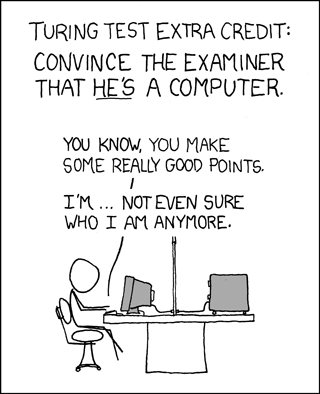329: Turing Test
| Turing Test |
 Title text: Hit Turing right in the test-tees |
Explanation
In brief, a Turing test is a test for assessing whether a machine/program demonstrates "intelligent" behaviour. Suggested by Alan Turing, the test involves a human examiner talking through a computer terminal to either a human or a computer -- which it is, is not known to the examiner. If the machine/program's responses convince the examiner that he/she is talking to a human, the machine/program is said to be passing the test. This comic suggests that extra credit should be awarded if the machine/program is capable of "counter-convincing" the examiner that he's actually a computer.
The most common implementation of a Turing test Internet users may see is the CAPTCHA (Completely Automated Program to Tell Computers and Humans Apart), which is often found on web site registration pages and usually involves trying to identify letters/numbers in an image. The text in the image is often distorted and/or in different colors or sizes or fonts, or may be very blurry as if from a very bad photocopy. This is to deter an automated OCR(Optical Character Recognition) program from easily identifying the characters. The idea is that humans can process and decipher things from highly distorted pictures much easier than (current) computer algorithms can.
The caption makes a play on words, in that extra credit (optional additional work to perform) is sometimes offered on curricular examinations ("tests") to allow the taker to increase his or her total score by demonstrating a heightened understanding of the subject, but the Turing test is not such a test. (This misapplication of vernacular associated with academic testing to a non-academic procedure that also bears the name test is a common vehicle of humor, as in "what if I take a blood test, and don't pass?" One may pass or fail an academic exam, but a blood test only identifies blood type, and the concept of passing or failing is not applicable.)
Similarly, the title text makes a play on words with "test-tees" vs testes suggesting that such extra credit would be an ironic twist to Turing test. (Hitting, or kicking, an adversary in the testes is considered dirty fighting.) This play on words is actually itself a form of aural CAPTCHA; humans can processes and recognize puns for what they are, but machines generally run afoul of the ambiguity.
A person with an appreciation for macabre humor will note that actually hitting Alan Turing in the testes would be rendered somewhat ineffectual by the fact that the British government chemically castrated him after he was convicted of "gross indecency" (Victorian-era code for "homosexuality") under the Labouchere Amendment in 1952. Whether or not this was intended by Randall is uncertain.
Transcript
- Screen 1:
- Title:
- Turing test extra credit:
- Convince the examiner that he's a computer.
- Examiner:
- You know, you make some really good points.
- I'm... not even sure who I am any more
Discussion
I think this is also a pretty obvious joke about Cleverbot, which constantly insists that you are a robot and it is a human. (See also 948: AI) 24.41.66.114 02:33, 16 September 2013 (UTC)
- I disagree, I think that's stretching it. Randall doesn't usually use others' punchlines wholesale, this seems like an original joke, and there are no references to Cleverbot to place the joke into that context. 108.162.249.155 03:39, 10 March 2016 (UTC)
Victorian era ended in 1901
Turing was convicted in 1952. 108.162.216.69 (talk) (please sign your comments with ~~~~)
The law was Victorian (1885), not the conviction. 23:52, 11 February 2015 (UTC)
"Chemical castration" simply reduces the libido - so hitting Turing in the testes would induce the same pain as in any other man.141.101.98.215 12:44, 21 May 2015 (UTC)
Shouldn't the description for the Turing test be changed to "demonstrate human-like behavior"? -- Flewk (talk) (please sign your comments with ~~~~)